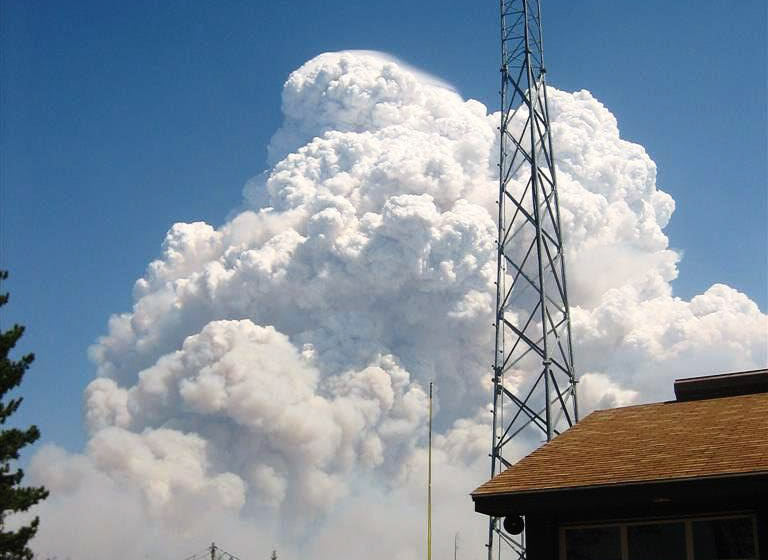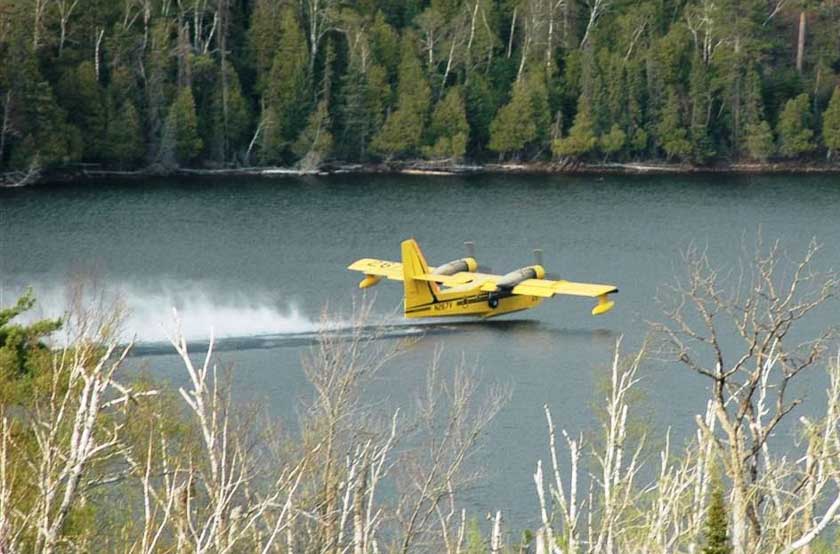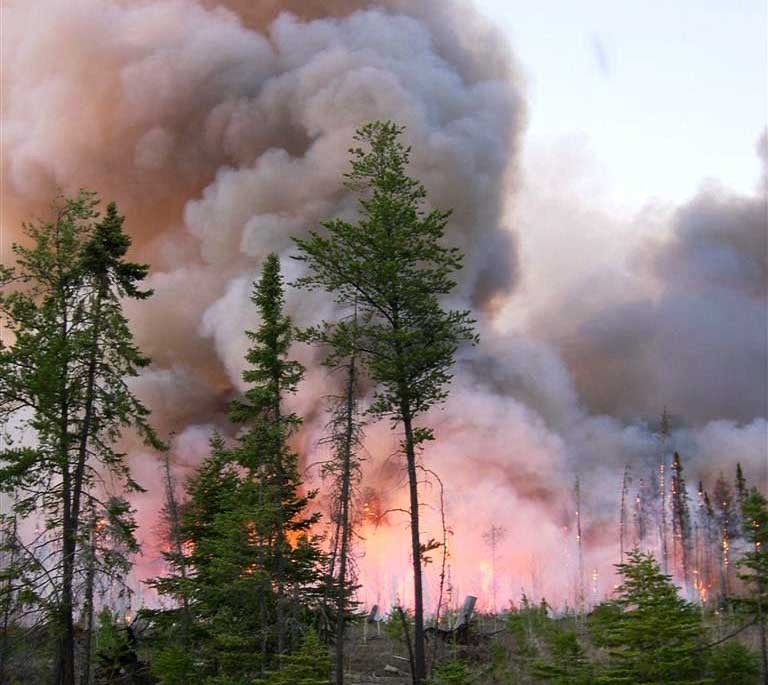Above: Eiler Fire, northern California, August 6, 2014. Photo by Bill Gabbert.
As the climate shifts and fires become larger, more resistant to control, and occur over longer fire seasons, protecting private property and adapting to a new paradigm can become more challenging.
A recently published paper written by 12 authors has some insights to the issue that are rarely seen. The title is Adapt to more wildfire in western North American forests as climate changes. The entire 2.7mb paper can be downloaded here.
Below are some excerpts.
****
….In delivering this message, we focus specifically on the distinction between specified, adaptive, and transformative resilience (15, 16). Rigorous definition and critical assessment of resilience to wildfire are needed to develop effective policy and management approaches in the context of climate change. We suggest an approach based on the concept of adaptive resilience, or adjusting to changing fire regimes (e.g., shifts in prevailing fire frequency, severity, and size) to reduce vulnerability and build resilience into social–ecological systems (SESs). Adaptive resilience to wildfire means recognizing the limited impact of past fuels management, acknowledging the important role of wildfire in maintaining many ecosystems and ecosystem services, and embracing new strategies to help human communities live with fire. Our discussion focuses on western North American forests but is relevant to fire-influenced ecosystems across the globe. We emphasize that long-term solutions must integrate relevant natural and social science into policies that successfully foster adaptation to future wildfire.
Fire suppression, in addition to past logging and grazing and invasive species, has led to a build-up of fuels in some ecosystems, increasing their vulnerability to wildfire. For example, drier, historically open coniferous forests in the West (“dry forests”) have experienced gradual fuels build-up in response to decades of fire suppression and other land-use practices (8, 22, 23).
Historically, predominantly frequent, low-severity fires killed smaller, less fire-resistant trees and maintained low-density dry forests of larger, fire-resistant trees. Large, high-severity fires now threaten to convert denser, more structurally homogeneous dry forests to nonforest ecosystems, with attendant loss of ecosystem services (24). However, only forests in the Southwest show a clear trend of increasing fire severity over the last three decades, and only a quarter to a third of the area burned in the western United States experienced high severity during that time (25, 26). Although fuels build-up in dry forests can increase the area burned because of higher contagion, the 462% increase in the frequency of large fires in southwestern forests since the 1970s is also a result of an extension of the fire season by 3.6 mo [the average for the western United States is 2.8 mo (21)]. Overall, dry forests account for about half of the total forest burning in the western United States since 1984.
Management guided by specified resilience often values recent ecological and social dynamics, particularly when the goal is the conservation of particular species or landscapes. Such management is often informed by short temporal windows of HRV, or “recent HRV” (rHRV) (Fig. 3). This approach can be useful for responding to fires in the short term. However, when social and environmental conditions change rapidly, this approach may foster management goals that are unrealistic or unsustainable in the long run (48, 49).
Managing Fuels
Limiting Reliance on Fuels Treatments to Alter Regional Fire Trends. Managing forest fuels is often invoked in policy discussions as a means of minimizing the growing threat of wildfire to ecosystems and WUI communities across the West. However, the effectiveness of this approach at broad scales is limited. Mechanical fuels treatments on US federal lands over the last 15 y (2001–2015) totaled almost 7 million ha (Forests and Rangelands, https://www.forestsandrangelands.gov/), but the annual area burned has continued to set records.
Regionally, the area treated has little relationship to trends in the area burned, which is influenced primarily by patterns of drought and warming (2, 3, 20). Forested areas considerably exceed the area treated, so it is relatively rare that treatments encounter wildfire (73). For example, in agreement with other analyses (74), 10% of the total number of US Forest Service forest fuels treatments completed 2004–2013 in the western United States subsequently burned in the 2005–2014 period (Fig. 6). Therefore, roughly 1% of US Forest Service forest treatments experience wildfire each year, on average.
The effectiveness of forest treatments lasts about 10–20 y (75), suggesting that most treatments have little influence on wildfire. Implementing fuels treatments is challenging and costly (7, 13, 76, 77); funding for US Forest Service hazardous fuels treatments totaled $3.2 billion over the 2006–2015 period (6). Furthermore, forests account for only 40% of the area burned since 1984, with the majority of burning in grasslands and shrublands.
As a consequence of these factors, the prospects for forest fuels treatments to promote adaptive resilience to wildfire at broad scales, by regionally reducing trends in area burned or burn severity, are fairly limited.
Creating Fire-Adapted Communities.
The majority of home building on fire-prone lands occurs in large part because incentives are misaligned, where risks are taken by homeowners and communities but others bear much of the cost if things go wrong. Therefore, getting incentives right is essential, with negative financial consequences for land-management decisions that increase risk and positive financial rewards for decisions that reduce risk. For example, shifting more of the wildfire protection cost and responsibility from federal to state, local, and private jurisdictions would better align wildfire risk with responsibility and provide meaningful incentives to reduce fire hazards and vulnerability before wildfires occur.
Currently, much of the responsibility and financial burden for community protection from wildfire falls on public land-management agencies. This arrangement developed at a time when few residential communities were embedded in fire-prone areas. Land-management agencies cannot continue to protect vulnerable residential communities in a densifying and expanding WUI that faces more wildfire (12).
The US Government Accountability Office questioned the US Forest Service’s prioritizing protection of WUI communities that lie under private and state jurisdictions and has argued for increased financial responsibility for WUI wildfire risk by state and local governments (93). This shift in obligation would enhance adaptive governance and could increase the motivation to pursue adaptive resilience of WUI communities to increasing wildfire (94).
Key aspects of an adaptive resilience approach are:
- recognizing that fuels reduction cannot alter regional wildfire trends;
- targeting fuels reduction to increase adaptation by some ecosystems and residential communities to more frequent fire;
- actively managing more wild and prescribed fires with a range of severities; and
- incentivizing and planning residential development to withstand inevitable wildfire.
These strategies represent a shift in policy and management from restoring ecosystems based on historical baselines to adapting to changing fire regimes and from unsustainable defense of the wildland– urban interface to developing fire-adapted communities.
The authors of the paper are: Tania Schoennagel, Jennifer K. Balch, Hannah Brenkert-Smith, Philip E. Dennison, Brian J. Harvey, Meg A. Krawchuk, Nathan Mietkiewiczb, Penelope Morgan, Max A. Moritz, Ray Rasker, Monica G. Turner, and Cathy Whitlock.
Thanks and a tip of the hat go out to Ben.
Typos or errors, report them HERE.












